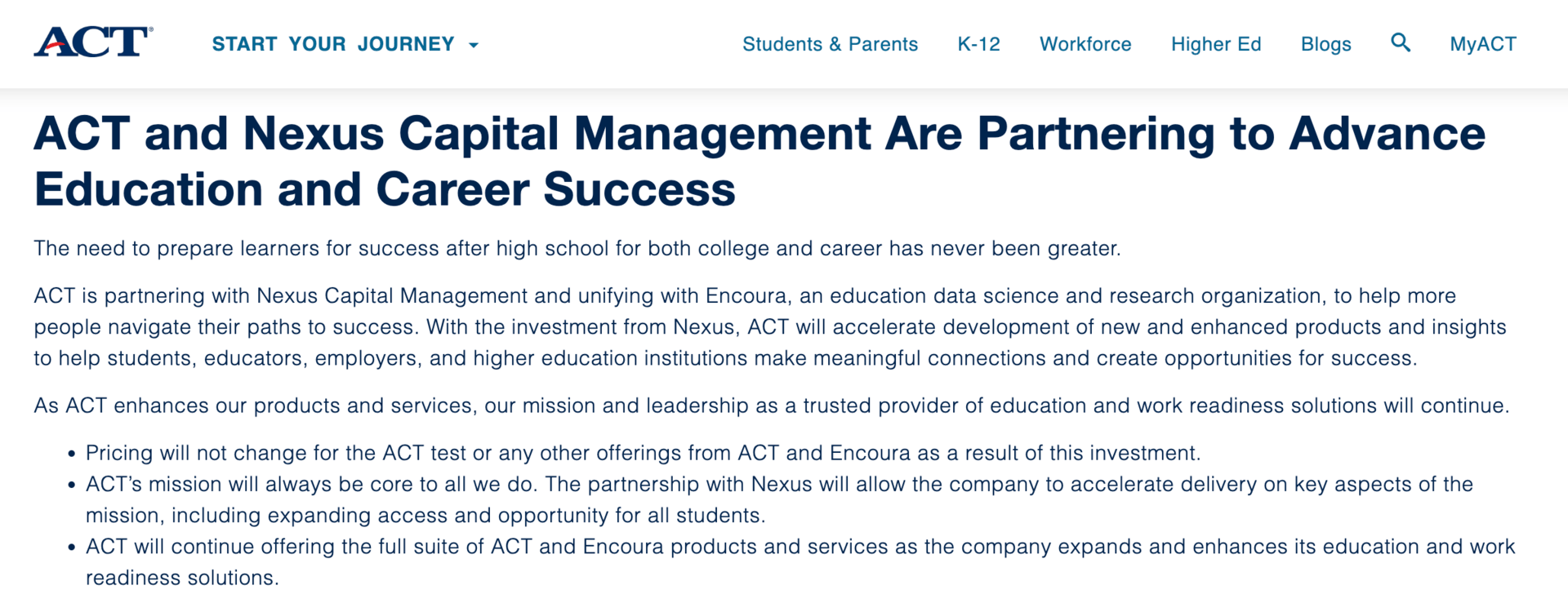Nexus Playing Both Sides in Anthology's Bankruptcy
A troubling lack of transparency about the private equity firm shaping Anthology’s fate

Was this forwarded to you by a friend? Sign up, and get your own copy of the news that matters sent to your inbox every week. Sign up for the On EdTech newsletter. Interested in additional analysis? Upgrade to the On EdTech+ newsletter.
Update 3 Oct 2025: Earlier public information suggested ACT and Encoura were unified. I’ve since confirmed they remain separate portfolio companies under Nexus. This highlights the broader issue: the filings rely on public info that is wrong or outdated. The post has been updated accordingly, and there will be more of an explanation next week.
Well, this has ended up being Anthology week. We’ll get to other issues such as Big Tech’s approach to EdTech and a Moodle update next week.
This week’s Anthology developments highlight something more troubling than balance sheets: the quiet but powerful role Nexus is playing on both sides of the bankruptcy process.
Nexus’ Dual Role
Thanks to Justin from ListEdTech and Morgan in a private conversation, I realized yesterday that Nexus Capital is playing a key role on both sides of the bankruptcy. That group is the one driving the auction process and bankruptcy plans that include splitting up Anthology, and they also own or have a major stake in one of the parties buying Anthology assets. All without flagging or highlighting these dual roles in the court filings. Before I explain, I’ll note that we’re likely talking about the appearance of a conflict of interest more than a conflict of interest. And I’ll note that outside of court documents the relationship is quite public. However, it is possible that Anthology’s breakup can be traced back to this dual role.
On the Creditor Side
There was a big change in strategy in the spring, as highlighted in my first post.
January–March: Anthology messaging was upbeat. On EdTech coverage from January noted the growing tension between optimistic PR and the reality of debt service and that there was already an agreement for debtors to take possession, albeit by doing this out of court (no formal bankruptcy).
April–September: The company formally shopped its assets, and On EdTech coverage from April noted that PE owner Veritas was essentially walking away, not seeking any ownership as part of the restructuring. In our May coverage, I noted that distressed debt investors were entering the picture and an out-of-court deal was unlikely. In July I named Nexus and Oaktree. Potential buyers, including direct competitors, reviewed the books. No prepetition deal that would have avoided bankruptcy materialized, but the process did lead to the two stalking-horse bids from Ellucian and Encoura.
The strategy changed from keeping Anthology intact and handing over the company to debt holders out of court. Once Nexus and Oaktree got involved (primarily Nexus), this changed to a sales process soliciting bids for all or parts of the company, and the specific outcome is the current Chapter 11 bankruptcy process.
The prepetition plans include three elements based on the four business segments.
The Enterprise Operations segment (think SIS and ERP) will be sold to Ellucian.
The Lifecycle Management (think CRM and others) and Student Success (think call center and services) will be sold to Encoura.
The remaining Teaching & Learning (think LMS) will be the core of the remaining company which will be rebranded as Blackboard.

On the Bidder Side
What Justin noted in yesterday’s post that I had forgot is that Nexus owns Encoura. 1 More specifically, Nexus made this investment last year when it became the majority investor in Encoura through ACT.
ACT, the mission-driven provider of the assessments, research, and work-ready credentials designed to support education and workplace success, today announced a new partnership with Nexus Capital Management LP, a Los Angeles-based private equity firm. [snip]
Upon closing, ACT and Encoura, an education data science and research organization that is a wholly owned subsidiary of ACT, will unify and operate as a public benefit corporation, with ACT’s name and brand.
The specific strategy enabled by this Nexus investment is essentially Lifecycle Engagement and Student Success.
“Our partnership with Nexus Capital Management uniquely positions ACT to meet a watershed moment in our nation, as the demand for talent is growing and becoming more diverse. The need to prepare learners for success after high school for both college and work has never been higher, nor has the need to ensure that every learner has access to equitable college and career planning resources, guidance, and insights,” ACT CEO Janet Godwin said.
Nexus was not just another investor. Nexus was the driving force to expand ACT’s Encoura’s expansion into the exact areas that they are the stalking horse bidders for with Anthology’s breakup. For $50 million.

On the Transparency Side
Nexus’ role on both sides is likely from separate investment funds, and there is likely a good explanation, but the problem is that this was not done in the court filings. There was one minor disclosure, but no flagging of this dual role and no explanation of how the process was ensuring arms-length negotiations.
All descriptions of the Encoura stalking horse bid only reference Encoura LE LLC, with no disclosure of ownership stakes, board rights, or control mechanisms.
The only reference to Nexus on the bidding side was in the Encoura Asset Purchase Agreement where the “Availability of Funds” section states the purchaser has an equity commitment letter from “Nexus Special Situations III, L.P. and Nexus Special Situations IV, L.P.” to fund the acquisition.
Yes, Nexus is there in the Asset Purchase Agreement equity commitment letter, but only in the fine print, not in the sections meant to orient judges or stakeholders. The standard should be much higher to ensure that the court fully understands the dual role and potential conflict and whether or not there was a fair arms-length process leading us to this point.
I am not a lawyer, but I do understand that Section 363 of the Bankruptcy Code has provisions on this subject.
§363(b) & (f): Allow the debtor to sell assets “outside the ordinary course” free and clear of liens, but the court must approve the sale as being in the best interests of the estate and the result of an arm’s-length, good-faith negotiation.
§363(m): Provides protection for a buyer acting in “good faith” from later reversal on appeal. Courts take “good faith” to mean no collusion, no insider favoritism, no unfair advantage.
Implication here: Since Encoura (controlled by Nexus, a major creditor and DIP backer) is the stalking horse, the relationship should be disclosed so the judge can assess whether the process is truly fair, arm’s-length, and in good faith.
Under §363 of the Bankruptcy Code, the court can approve a sale of assets if it is done in the best interest of creditors and the buyer acts in good faith. That means no hidden insider advantages or undisclosed conflicts. If the buyer is affiliated with a major creditor, as is the case with Nexus, then the judge and other stakeholders need that fact on the record to evaluate fairness.
Separately, Bankruptcy Rule 2014 requires the debtor’s professionals (lawyers, bankers) to disclose all connections with creditors, bidders, or related parties. Courts interpret this broadly: if there’s a material link between a stalking horse bidder and a controlling creditor, it should be disclosed up front.
The Missing Narrative
To me, this is crucial information, even if the process itself was in good faith. The problem is a lack of disclosure to the courts and to the public. And it is relevant from a strategic level - I am not alleging preferential treatment of Encoura’s bid. But I am saying that this timeline should have been fully disclosed.
April 2024: ACT acquires the majority of Encoura ACT and combines with Encoura into one operational unit, specifically to expand services into Lifecycle Engagement and Student Success (more or less, not in those words).
January 2025: Anthology and its equity and debt owners have an informal plan to transfer ownership to alleviate the debt crisis while keeping the company intact.
January - April 2025: Nexus and Oaktree buy up corporate bonds and become the controlling creditors driving the process.
September 2025: Anthology declares bankruptcy based on plans that breakup the company, with Nexus-owned ACT Encoura agreeing to buy business segments that align with their Nexus-driven strategy.
That should have been flagged for the court, fully explained, and with a narrative convincing the court that the process was in good faith with no undisclosed conflicts. But all we got was one buried availability of funds disclosure and no explanation.
The main On EdTech newsletter is free to share in part or in whole. All we ask is attribution.
Thanks for being a subscriber.
1 The fact that I forgot, as did others I have talked to, is actually the point. Someone would have to remember and search and connect dots to understand the relationship instead of having a clear description in the court filings.
